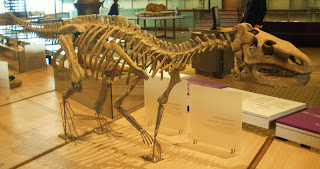I can't believe that I just yesterday learned about Hațeg Island and its small dinosaurs.Hațeg Island was a large offshore island in the Tethys Sea, that is, the ancient sea betwen Europe, Asia, and Africa, more or less where the Mediterranean and Black Seas are today. It existed during the Late Cretaceous period, probably from around 100 to 66 million years ago. Rocks from this island were discovered near modern-day Hațeg, Romania. The island was lifted by the same mountain-building episode that gave us the Balkans and the Anatolian highlands. Wikipedia suggests that Hainan Island, off the southern coast of China, is a good comparison in terms of size, topography, and climate.
The fascinating thing about Hațeg Island is that the patterns of animal life we know from modern islands were present there in distorted, dinosaur-age form. For example, most terrestrial animals were smaller than their mainland forms. Above are a skeleton of an Inguanadon of the genus Zalmoxes, named after a Thracian god about whom Herodotus told stories of human sacrifice, and a diagram showing how much smaller it was (in purple) than most other Iguanadons. The diagram at the top of the post compares Zalmoxes robustus, from Hațeg, to the next smallest known species.Here's a Titanosaur from Hațeg called Magyarosaurus. Most Titanosaurs were gigantic beasts, but this one was horse-sized. (The grid is 1-meter squares).
But while many species shrank on the island, the opposite also happened. Just as some islands came to be inhabited by huge flightless birds, Hațeg was home to gigantic pterosaurs. This is Hatzegopteryx, probably the dominant predator on the island. Only very partial fossil remains have been found, so it is unclear whether Hatzegopteryx could fly. But it certainly didn't need to.
Sunday, June 4, 2023
Subscribe to:
Post Comments (Atom)








No comments:
Post a Comment